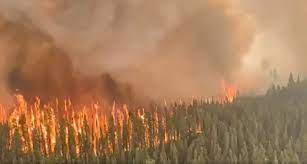Ranvir S. Nayar
One of the main global media headlines over the past week has been the uncontrolled wildfires in Canada that have resulted in dense clouds of smoke blanketing large swathes of the northeastern US, most notably New York and New Jersey, leaving more than 100 million people struggling to breathe and carry on with their normal daily lives.
Such fires — which are currently raging over 3.3 million hectares, or 33,000 sq. km, equivalent to about 40 percent of the landmass of the UAE — are an annual occurrence in Canada between May and September. What is worrying is that they have been growing in scope, covering much larger areas than ever before, and beginning much earlier in the season. For instance, in just six weeks this year the fires have set new records in terms of spread and the amount of damage caused.
The scale of the fires this year can be blamed in part on a drought and the intense heat that has hit North America, which is in turn in direct correlation to the effects of climate change and global warming that are playing havoc with the world at large.
While the current headlines have largely focused on New York and Canada, at this time of year wildfires have become the norm across large areas of the planet, especially in the northern hemisphere where they mark the onset of summer. Incidentally, summers are not only becoming much hotter but also longer, setting in much earlier in the year and typically overstaying their welcome.
So this year, even as Canada has hogged the headlines, wildfires have also broken out in Europe and other parts of the world. For instance, on March 23, three days after the spring season began, Spain reported its first major wildfire of the year, which burned through 4,000 hectares within hours on the first day alone.
Fires are also burning in Italy and France, the latter of which has barely recovered from last year, one of its worst-ever wildfire seasons, during which it lost 66,000 hectares of forest — almost seven times the average annual loss, which stands at about 9,900 hectares each year between 2006 and 2021.
Almost every year, fires are proving to be more frequent, more intense, much longer lasting and much more damaging than the preceding year. This is due to a mix of factors, mainly human-driven activities but also the rapidly deteriorating state of the global environment — which is also the result of human activities.
Wildfires leave huge swathes of destruction in their wake and cause hundreds of billions of dollars in damages and losses each year. The first and foremost impact is, of course, on the global forests that have been under relentless attack by humans as the toll of industrial logging continues to rise across the world, severely depleting forest resources globally.
In the first 20 years of this millennium, according to the Global Forest Watch, forests dwindled by 101 million hectares worldwide, an area equivalent to that of Ethiopia. Fires were responsible only for 27 percent of this; the rest was the direct result of human activities such as logging, urbanization and agriculture.
Wildfires and forest loss are not limited to any one country or region but affect almost all nations. Therefore it is important to mount a coordinated and global response. It is evident that no country, however rich or well-equipped it might be, can tackle forest fires effectively alone.
It is time for us to accept that these wildfires are here to stay and we can only realistically attempt to manage them, not control them or banish them entirely from the planet. This will require not only a global response, with coordination between governments and institutions, but, more importantly, involves action from all of us.
It is important to create awareness among people about how small, careless actions, such as dropping cigarette butts or failing to properly extinguish campfires, can cause major catastrophes.
Managing forest fires requires the involvement of a large number of stakeholders, the first and foremost of whom are the indigenous communities that have lived in these forests for thousands of years, because they are the ones who suffer the most as a result of wildfires. Governments and civil society organizations must ensure that the interests of these communities and their homelands are protected as effectively as possible.
This requires curbs on the growing incursions by organized and industrial economic activities such as large-scale agriculture, logging and plantation. The main factor responsible for uncontrolled, preventable fires is the trend of monoculture plantations that has taken hold of industrial or corporate forestry. This means the same type of plant or tree is planted across thousands of hectares of land, without any thought to diversification to help reduce the risk not only of fires but also diseases that can spread from tree to tree throughout a plantation.
The human invasion of forests has left them more vulnerable to wildfires as the loss of biodiversity has removed many of the natural buffers that once existed, and still exist in some parts of the world, to prevent fires from spreading to the extent they do today.
These buffers include lakes, rivers, rocky outcrops and ridges. However, as lakes and rivers dry up, for example, these barriers are no longer so effective and, in their greed to maximize output from plantations, many companies ignore advice to leave uncultivated areas clear of vegetation to effectively act as firebreak and help prevent fires from spreading.
In view of the rapidly rising number of tourists heading to the forests of the world, either on camping trips or simply days out, it is also very important for tourism authorities to regulate the number of people allowed in core forest areas at any one time, not only to minimize the chances of an accidental fire but also to curb the damage caused to forests and biodiversity by the growing numbers of human visitors.
It is also vital for countries to cooperate with each other. Those nations that are relatively well-equipped and have a well-trained force of fire officers could offer training to professionals from other countries. Many need help to develop a common firefighting lexicon and their professionals need to be trained in fire control techniques and safety mechanisms.
As New Yorkers have clearly realized this week, and Europeans and Asians have been aware for some time, fires are not only a problem for the countries in which they break out, but can also cause widespread disruption many hundreds of miles away. It is important, therefore, that the whole world comes together to fight this menace in the best possible manner.







